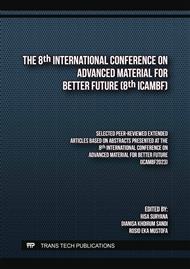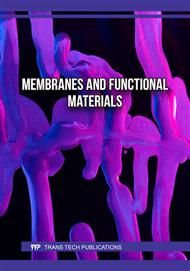[1]
P. Ganguly, S. Sengupta, P. Das, and A. Bhowal, 'Valorization of food waste: Extraction of cellulose, lignin and their application in energy use and water treatment', Fuel, vol. 280, p.118581, 2020.
DOI: 10.1016/j.fuel.2020.118581
Google Scholar
[2]
M. R. Ridho et al., 'Lignin as Green Filler in Polymer Composites: Development Methods, Characteristics, and Potential Applications', Adv. Mater. Sci. Eng., vol. 2022, 2022.
DOI: 10.1155/2022/1363481
Google Scholar
[3]
C. Huang, Z. Peng, J. Li, X. Li, X. Jiang, and Y. Dong, 'Unlocking the role of lignin for preparing the lignin-based wood adhesive: A review', Ind. Crops Prod., vol. 187, no. PA, p.115388, 2022.
DOI: 10.1016/j.indcrop.2022.115388
Google Scholar
[4]
R. C. Sun, 'Lignin Source and Structural Characterization', ChemSusChem, vol. 13, no. 17, p.4385–4393, 2020.
DOI: 10.1002/cssc.202001324
Google Scholar
[5]
H. M. Wang, T. Q. Yuan, G. Y. Song, and R. C. Sun, 'Advanced and versatile lignin-derived biodegradable composite film materials toward a sustainable world', Green Chem., vol. 23, no. 11, p.3790–3817, 2021.
DOI: 10.1039/d1gc00790d
Google Scholar
[6]
A. Ovejero-Pérez, V. Rigual, J. C. Domínguez, M. V. Alonso, M. Oliet, and F. Rodriguez, 'Organosolv and ionosolv processes for autohydrolyzed poplar fractionation: Lignin recovery and characterization', Int. J. Biol. Macromol., vol. 197, no. August 2021, p.131–140, 2022.
DOI: 10.1016/j.ijbiomac.2021.12.079
Google Scholar
[7]
R. E. de Souza, F. José Borges Gomes, E. O. Brito, and R. C. Costa Lelis, 'A review on lignin sources and uses', J. Appl. Biotechnol. Bioeng., no. March 2022, p.100–105, 2020.
DOI: 10.15406/jabb.2020.07.00222
Google Scholar
[8]
Y. Li, F. Li, Y. Yang, B. Ge, and F. Meng, 'Research and application progress of lignin-based composite membrane', J. Polym. Eng., vol. 41, no. 4, p.245–258, 2021.
DOI: 10.1515/polyeng-2020-0268
Google Scholar
[9]
M. Mariana et al., 'A current advancement on the role of lignin as sustainable reinforcement material in biopolymeric blends', J. Mater. Res. Technol., vol. 15, p.2287–2316, 2021.
DOI: 10.1016/j.jmrt.2021.08.139
Google Scholar
[10]
S. Sahoo, M. Misra, and A. K. Mohanty, 'Enhanced properties of lignin-based biodegradable polymer composites using injection moulding process', Compos. Part A Appl. Sci. Manuf., vol. 42, no. 11, p.1710–1718, 2011.
DOI: 10.1016/j.compositesa.2011.07.025
Google Scholar
[11]
C. Ma, T. H. Kim, K. Liu, M. G. Ma, S. E. Choi, and C. Si, 'Multifunctional Lignin-Based Composite Materials for Emerging Applications', Front. Bioeng. Biotechnol., vol. 9, no. July, p.1–12, 2021.
DOI: 10.3389/fbioe.2021.708976
Google Scholar
[12]
K. Chen, P. Li, X. Li, C. Liao, X. Li, and Y. Zuo, 'Effect of silane coupling agent on compatibility interface and properties of wheat straw/polylactic acid composites', Int. J. Biol. Macromol., vol. 182, no. June, p.2108–2116, 2021.
DOI: 10.1016/j.ijbiomac.2021.05.207
Google Scholar
[13]
S. Bairagi and S. W. Ali, 'Effects of surface modification on electrical properties of KNN nanorod-incorporated PVDF composites', J. Mater. Sci., vol. 54, no. 17, p.11462–11484, 2019.
DOI: 10.1007/s10853-019-03719-x
Google Scholar
[14]
A. Basith, Venny, A. F. Ni'mah, N. R. Mu'izzah, G. P. W. Sejati, and E. Pramono, 'Effect of Organosilane Functionalization of Kaolinite In Structure and Thermal Properties', J. Phys. Conf. Ser., vol. 2556, no. 1, p.012015, 2023.
DOI: 10.1088/1742-6596/2556/1/012015
Google Scholar
[15]
C. Qin, W. Lu, Z. He, G. Qi, J. Li, and X. Hu, 'Effect of silane treatment on mechanical properties of polyurethane/mesoscopic fly ash composites', Polymers (Basel)., vol. 11, no. 4, p.1–16, 2019.
DOI: 10.3390/polym11040741
Google Scholar
[16]
R. Liu et al., 'A Versatile Approach Towards the Fast Fabrication of Highly-Permeable Polymer Mesoporous Membranes', ChemistrySelect, vol. 1, no. 12, p.3049–3053, 2016.
DOI: 10.1002/slct.201600256
Google Scholar
[17]
M. Waqas et al., 'Multifunctional Cathodic Interlayer with Polysulfide Immobilization Mechanism for High-Performance Li-S Batteries', ChemistrySelect, vol. 5, no. 38, p.12009–12019, 2020.
DOI: 10.1002/slct.202003381
Google Scholar
[18]
J. Ji, F. Liu, N. A. Hashim, M. R. M. Abed, and K. Li, 'Poly(vinylidene fluoride) (PVDF) membranes for fluid separation', React. Funct. Polym., vol. 86, p.134–153, 2015.
DOI: 10.1016/j.reactfunctpolym.2014.09.023
Google Scholar
[19]
R. S. Silitonga et al., 'The modification of PVDF membrane via crosslinking with chitosan and glutaraldehyde as the crosslinking agent', Indones. J. Chem., vol. 18, no. 1, p.1–6, 2018.
DOI: 10.22146/ijc.25127
Google Scholar
[20]
R. A. Nugroho et al., 'Comprehensive Study of Physicochemical Properties in Poly‐ Vinylidene Fluoride', vol. 9, no. e202304113, p.1–9, 2024, doi: https://doi.org/10.1002/ slct.202304113.
Google Scholar
[21]
N. R. Mu'izzah, P. Z. Hapsari, N. P. Aulia, D. W. T. Wulansari, F. Azhari, and E. Pramono, 'Utilization of Lignin and Lignosulfonate from Oil Palm Empty Fruit Bunches as Filler in PVDF Proton Exchange Membrane Fuel Cell', Indones. J. Chem., vol. 23, no. 4, p.1042–1053, 2023.
DOI: 10.22146/ijc.81750
Google Scholar
[22]
N. A. Zakaria et al., 'Lignin modified PVDF membrane with antifouling properties for oil filtration', J. Water Process Eng., vol. 43, p.102248, 2021.
DOI: 10.1016/j.jwpe.2021.102248
Google Scholar
[23]
H. Mao et al., 'PVDF ultrafiltration membrane with enhanced mechanical and filtration performance by hydrophilic pH-response nanofibers modification', Sep. Purif. Technol., vol. 314, no. February, p.123613, 2023.
DOI: 10.1016/j.seppur.2023.123613
Google Scholar
[24]
Harmaja Simatupang, Andi Nata, and Netti Herlina, 'Studi Isolasi Dan Rendemen Lignin Dari Tandan Kosong Kelapa Sawit (Tkks)', J. Tek. Kim. USU, vol. 1, no. 1, p.20–24, 2012.
DOI: 10.32734/jtk.v1i1.1401
Google Scholar
[25]
N. Thungphotrakul, P. Dittanet, S. Loykulnunt, S. Tanpichai, and P. Parpainainar, 'Synthesis of sodium lignosulfonate from lignin extracted from oil palm empty fruit bunches by acid/alkaline treatment for reinforcement in natural rubber composites', IOP Conf. Ser. Mater. Sci. Eng., vol. 526, no. 1, 2019.
DOI: 10.1088/1757-899X/526/1/012022
Google Scholar
[26]
E. Pramono, G. P. W. Sejati, S. Wahyuningsih, and C. Purnawan, 'Polyvinylidene Fluoride (PVDF)/Modified Clay Hybrid Membrane for Humic Acid and Methylene Blue Filtration', Indones. J. Chem., vol. 23, no. 2, p.425–437, 2023.
DOI: 10.22146/ijc.78979
Google Scholar
[27]
E. Pramono et al., 'Cellulose derived from oil palm empty fruit bunches as filler on polyvinylidene fluoride based membrane for water containing humic acid treatment', Groundw. Sustain. Dev., vol. 17, no. October 2021, p.100744, 2022.
DOI: 10.1016/j.gsd.2022.100744
Google Scholar
[28]
W. Tian, H. Li, J. Zhou, and Y. Guo, 'Preparation, characterization and the adsorption characteristics of lignin/silica nanocomposites from cellulosic ethanol residue', RSC Adv., vol. 7, no. 65, p.41176–41181, 2017.
DOI: 10.1039/c7ra06322a
Google Scholar
[29]
N. F. Sayakulu and S. Soloi, 'The Effect of Sodium Hydroxide (NaOH) Concentration on Oil Palm Empty Fruit Bunch (OPEFB) Cellulose Yield', J. Phys. Conf. Ser., vol. 2314, no. 1, 2022.
DOI: 10.1088/1742-6596/2314/1/012017
Google Scholar
[30]
O. K. Karimov, G. A. Teptereva, I. A. Chetvertneva, E. M. Movsumzade, and E. K. Karimov, 'The structure of lignosulfonates for production of carbon catalyst support', IOP Conf. Ser. Earth Environ. Sci., vol. 839, no. 2, 2021.
DOI: 10.1088/1755-1315/839/2/022086
Google Scholar
[31]
C. M. Popescu and M. Broda, 'Interactions between different organosilicons and archaeological waterlogged wood evaluated by infrared spectroscopy', Forests, vol. 12, no. 3, p.1–16, 2021.
DOI: 10.3390/f12030268
Google Scholar
[32]
K. F. El-Nemr, H. R. Mohamed, M. A. Ali, R. M. Fathy, and A. S. Dhmees, 'Polyvinyl alcohol/gelatin irradiated blends filled by lignin as green filler for antimicrobial packaging materials', Int. J. Environ. Anal. Chem., vol. 100, no. 14, p.1578–1602, 2020.
DOI: 10.1080/03067319.2019.1657108
Google Scholar
[33]
G. Cui, X. Wang, J. Xun, and T. Lou, 'Microwave assisted synthesis and characterization of a ternary flocculant from chitosan, acrylamide and lignin', Int. Biodeterior. Biodegrad., vol. 123, p.269–275, 2017.
DOI: 10.1016/j.ibiod.2017.07.011
Google Scholar
[34]
J. Zhang, X. Zhao, Q. Kong, X. Wang, and T. Lou, 'Preparation of chitosan/DADMAC/lignin terpolymer and its application of dye wastewater flocculation', Polym. Bull., vol. 79, no. 9, p.7479–7490, 2022.
DOI: 10.1007/s00289-021-03863-y
Google Scholar
[35]
J. Sameni, S. Krigstin, D. dos S. Rosa, A. Leao, and M. Sain, 'Thermal characteristics of lignin residue from industrial processes', BioResources, vol. 9, no. 1, p.725–737, 2014.
DOI: 10.15376/biores.9.1.725-737
Google Scholar
[36]
N. Zhou, W. P. D. W. Thilakarathna, Q. S. He, and H. P. V. Rupasinghe, 'A Review: Depolymerization of Lignin to Generate High-Value Bio-Products: Opportunities, Challenges, and Prospects', Front. Energy Res., vol. 9, no. January, p.1–18, 2022, doi: 10.3389/fenrg. 2021.758744.
DOI: 10.3389/fenrg.2021.758744
Google Scholar
[37]
L. Serrano, J. A. Cecilia, C. García-Sancho, and A. García, 'Lignin Depolymerization to BTXs', Top. Curr. Chem., vol. 377, no. 5, p.1–28, 2019.
DOI: 10.1007/s41061-019-0251-6
Google Scholar
[38]
N. S. Rosli, S. Harun, J. M. Jahim, and R. Othaman, 'Pencirian kimia dan fizikal bagi tandan kosong buah kelapa sawit', Malaysian J. Anal. Sci., vol. 21, no. 1, p.188–196, 2017.
DOI: 10.17576/mjas-2017-2101-22
Google Scholar
[39]
L. P. Santi, D. N. Kalbuadi, and D. H. Goenadi, 'Empty Fruit Bunches as Potential Source for Biosilica Fertilizer for Oil Palm', J. Trop. Biodivers. Biotechnol., vol. 4, no. 3, p.90–96, 2019.
DOI: 10.22146/jtbb.38749
Google Scholar



